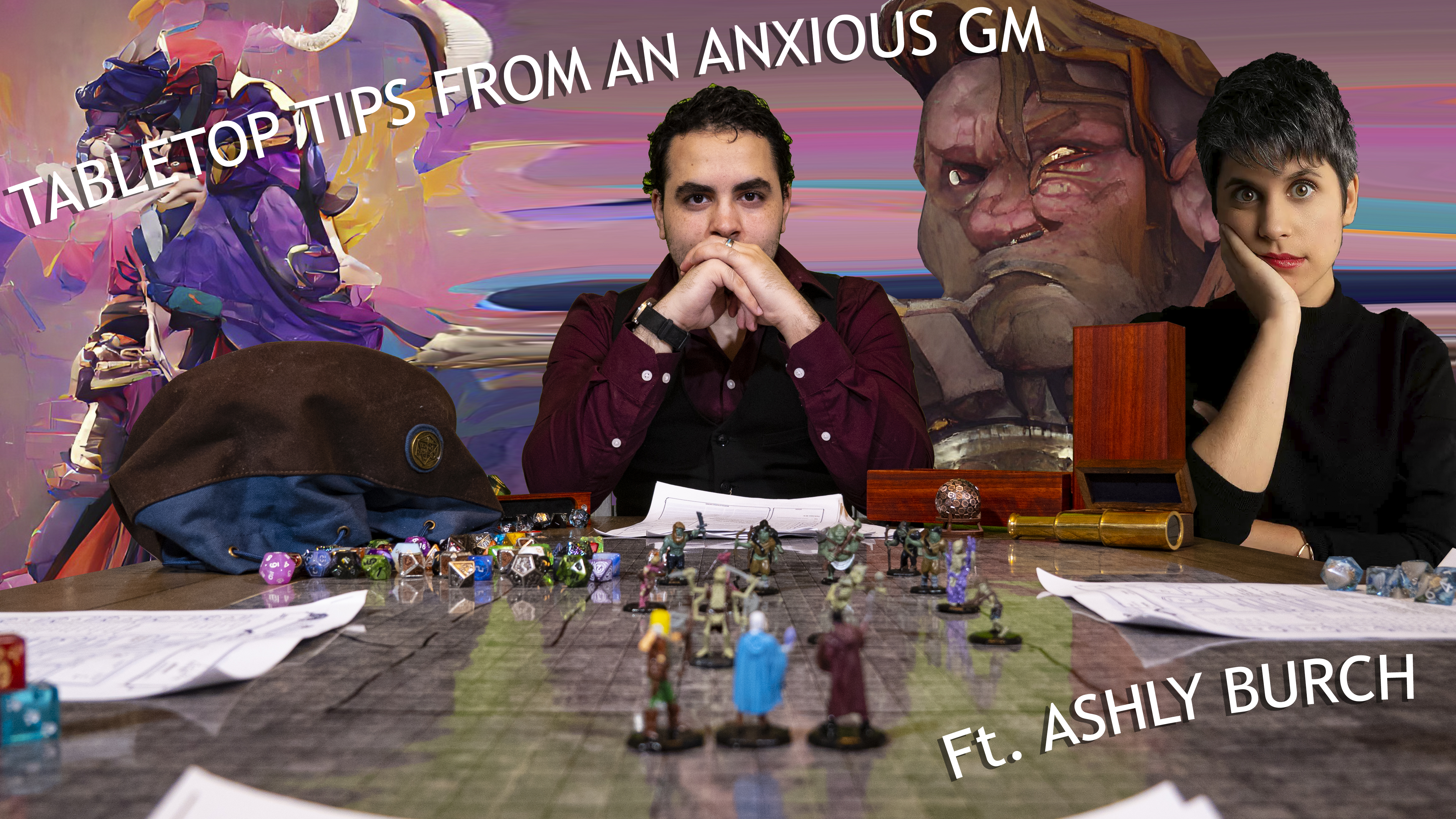Ashly Burch asks how do we encourage conflict without derailing the story? Tabletop tips from an anxious GM
Ashly Burch talks Keg and Molly

How does one encourage conflict within a party that doesn’t derail the story or lead to any hurt feelings? There’s almost always going to be character conflict, and that’s because people are inherently different. Everyone has their own personal compass that guides them, and no one compass is exactly the same. Fictional characters are no different. As someone who struggles with anxiety and depression — a combo that is less than ideal for a journalist or a game master juggling seven different players in a six-hour Dungeons & Dragons game — it’s hard to put yourself out there, especially when you risk hurting another player outside of the game.
I had the opportunity to interview Ashly Burch (Aloy in Horizon Forbidden West, Tiny Tina in Tiny Tina’s Wonderlands), and I couldn’t pass up the chance to chat about D&D and TTRPGs. In this week’s column of Tabletop tips from an anxious GM (all of which can be found on our DND tips hub), I’ll be answering a question from Ashly Burch herself.
“I was a guest on Critical Role, and I decided that I wanted to play a character that was a coward,” Burch stated, referencing Keg, a dwarven fighter from Shadycreek Run. “That, I would say, indirectly led to the death of a beloved cast member’s character. I think it led to a very interesting story (and a lot of anguish, which I’m very sorry for), but I’m curious about how to thread the needle and encourage conflict more in D&D parties that doesn’t derail the story [or] lead to hurt feelings and genuine player in-fighting.”
First of all, that character’s death was not Keg’s fault. Secondly, that death not only provided a super intense arc, but also gave us the biggest plot hook for the end of Critical Role’s Campaign 2. Conflict naturally creates interesting character and story moments, but that doesn’t always mean everyone is okay with what’s happening. Let me explain.
TL;DR
Communicate! Make roleplaying a safe space between the GM and players. If there’s conflict, talk about it in and out of the game to ensure everyone is okay. Encourage conflict. Conflict is the meat of a great narrative and at the heart of compelling character dynamics. So inhabit those character flaws and really dig deep into your persona. And GMs, throw some wicked roleplay conundrums their way!
Hurt the character, not the player. Make sure all of your conflicts stay in-game and don’t bleed into the real world. How? Just talk. Check in on your friends and ask how they’re doing. Put down limits if you need to. Unearth every potential story. Conflict breeds narrative, but not all narrative fits with our expectations, so before you blow a hole in your campaign, make sure the other players are okay with it out of character. However, isolated character conflicts are fun because it challenges each character’s beliefs and ideals, which stimulates character growth.
How to encourage conflict without hurting feelings or the story — an in-depth look

Communicate! I’ll shout this at the top of my lungs until players and GMs all understand that communication is key to a healthy and fun roleplaying space. In this case, it’s important to check in with your fellow players about the potential for tense situations, and gauge how comfortable they are with challenging character dynamics. For example, if you start a game with a Rogue that suffers from kleptomania, and a Cleric that wouldn’t hurt a fly, then that will certainly lead to conflict. Those two players should chat outside of the game and check in on each other’s limits concerning that potential conflict.
Stay in the know with Laptop Mag
Get our in-depth reviews, helpful tips, great deals, and the biggest news stories delivered to your inbox.
In the case of Critical Role, everyone at that table already trusts each other, including guests like Ashly Burch. Therefore, when that aforementioned character inevitably died, the player in question wasn’t upset at Ashly or Keg’s actions. Instead, it invested the players into a compelling revenge arc that even had Travis Willingham and Laura Bailey messaging Burch from the sidelines, writing “I want to fucking murder [Lorenzo]! Take his head clean off!”

Encourage conflict. There are narrative conflicts and character conflicts. It’s not that difficult to throw a narrative conflict at your players that’ll have them questioning each other. Moral quandaries are my favorite. For example, I had the elemental prince of fire, Imix, locked away in a prison where his body would fuel a city’s heat and power. This forced the players to choose whether or not they left Imix to rot in order to keep a city alive or damn the city in favor of relinquishing its slave labor. This led to fun roleplay that revealed some characters’ true colors.
Then there are character conflicts, which, in the Critical Role example, comes from Keg's cowardice. Character conflicts are slightly harder to encourage because it comes down to the individuality of the characters. Since D&D is a heavy combat-based TTRPG, cowardice will rear its head quite easily. However, there are subtler character flaws that can be tough to display. When you’re playing your character, keep in mind that you’re weaving a narrative as a group. You’re not trying to win a game, so take advantage of your flaws for some fun roleplay beats.
For example, I play a character called Captain Kaz, a hot-headed sorcerer that is as prideful as he is rageful. When he sees his goal in front of him, he’ll stop at nothing to get there even at the detriment of the party. That personality type led to compelling conversations between party members, and even opened doors to potential storylines that would have otherwise been inaccessible.

Hurt the character, not the player. I’ve talked about this before, but all of the expectations and limits for your campaign should be discussed in Session 0. However, that won’t account for people joining mid-campaign, characters that have shifted in personality, or unforeseen circumstances. Therefore, when things get a little heated between characters, it’s okay to take a second to check in on your fellow player and ensure that everything is copacetic. Some people use the X-card system, a great tool that indicates whether you’re uncomfortable with the content.
You need a safe space to roleplay in any TTRPG, and while conflict can lead to fun moments, ensure that you’re not overdoing it. Consider the feelings of your fellow players, but also think of the narrative. There’s a balance that needs to be struck, unique to every situation. In a narrative, you don’t want to see an anti-hero continuously commit villainous acts without any redeemable qualities — that’s just a two-dimensional villain at that point. People are three-dimensional, so your character shouldn’t be any different.

Unearth every potential story. Yes, player conflict can lead to interesting story beats, and even potentially disrupt the story entirely. I love character drama, especially when it flips the story upside down. However, not everyone falls into that category. Let’s talk about the difference between conflicts that provide story hooks and conflicts that change story hooks — and how to handle each scenario.
In Ashly Burch’s example, the conflict changed the story hook. The Mighty Nein were always going to hunt the Iron Shepherds to save their friends, but it was understood that this was a side-arc to fill in the space while the missing players were absent. However, this quickly became a critical moment in the campaign when the Shepherds murdered one of the Nein. So what do you do if something like this happens and your players are upset? Well, fix it! It’s a story. Write more, give us that epic plot twist, and most importantly, ensure that everyone at the table is comfortable.
If Matthew Mercer and the rest of the players weren’t comfortable with this turn of events, that character would have been brought back to life with a deus ex machina, but that’s not what they wanted. If that did happen, you wouldn’t have Caduceus Clay, you wouldn’t hate Lorenzo, and you wouldn't have the Tomb Takers arc. Conflict creates a compelling narrative.
Then there are conflicts that provide story hooks, which I believe should always be encouraged as long as everyone is comfortable with it. Conflicts that surround flaws like pride, prejudice, cowardice, lying, or faithlessness can develop into interesting story beats. Those flaws can conflict with another character’s ideals, and therefore change how you or they may act in a certain moment.
Going back to my Rogue and Cleric analogy, let’s say the Cleric is inspired to steal something because they’re influenced by the Rogue. Unfortunately, the Cleric stole from the wrong person, and now that sparked a small story hook where the Cleric needs to pay their penance. This could lead the Cleric to reaffirm their beliefs or even challenge them once again. Either way, it makes for a compelling character moment, which is a big part of what makes D&D and TTRPGs so endlessly compelling.

I hope this helps new players and GMs out there who are just jumping into TTRPGs. Stay tuned next week for another column based on a question from Sam Winkler, lead writer for Tiny Tina’s Wonderlands. If you liked this column and want to see it continue, you can send me your own questions concerning mechanical, narrative, or social issues in the tabletop gaming space. You can email me at rami.tabari@futurenet.com or find me on Twitter.

Rami Tabari is the Reviews Editor for Laptop Mag. He reviews every shape and form of a laptop as well as all sorts of cool tech. You can find him sitting at his desk surrounded by a hoarder's dream of laptops, and when he navigates his way out to civilization, you can catch him watching really bad anime or playing some kind of painfully difficult game. He’s the best at every game and he just doesn’t lose. That’s why you’ll occasionally catch his byline attached to the latest Souls-like challenge.
